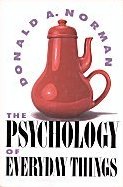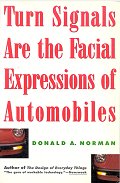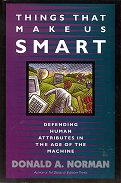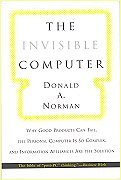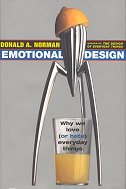If only today’s technology were simpler!
It’s the universal lament, but it’s wrong.
We don’t want simplicity. Simple tools are not up to the task.
The world is complex; our tools need to match that complexity.
Simplicity turns out to be more complex than we thought.
In this provocative and informative book,
Don Norman writes that the complexity of our technology must mirror the complexity and richness of our lives.
It’s not complexity that’s the problem, it’s bad design.
Bad design complicates things unnecessarily and confuses us.
Good design can tame complexity.
Norman gives us a crash course in the virtues of complexity.
But even such simple things as salt and pepper shakers, doors,
and light switches become complicated when we have to deal with many of them, each somewhat different.
Managing complexity, says Norman, is a partnership.
Designers have to produce things that tame complexity.
But we too have to do our part: we have to take the time to learn the structure and practice the skills.
This is how we mastered reading and writing, driving a car, and playing sports,
and this is how we can master our complex tools.
Complexity is good. Simplicity is misleading.
The good life is complex, rich, and rewarding—but only if it is understandable, sensible, and meaningful.
It is interesting to watch Norman’s design philosophy evolve over a series of books.
His 1988 classic The Psychology of Everyday Things
argues for simplicity and naturalness in design.
In his 2004 Emotional Design he is arguing for the consideration of
the users’ aesthetic reaction to that design.
And by 2007, in The Design of Future Things,
he is focussing on the need for good communication between our ever-“smarter” technologies and us.
This 2011 book, Living with Complexity,
admits that maybe simplicity and aesthetics isn’t the be-all and end-all of design.
Our world, both natural and technological, is a complex place, and we want rich, complex interactions with it.
Norman’s argument here is that good design should support that rich complexity,
rather than making life harder by being unnecessarily complicated.
[p2]
I use the word “complexity” to describe a state of the world.
The word “complicated” describes a state of mind.
The dictionary definition for “complexity” suggests things with many intricate and interrelated parts, which is just how I use the term.
The definition for “complicated” includes as a secondary meaning “confusing,” which is what I am concerned with in my definition of that word.
There is a consequence of wanting rich complexity, however:
it takes time to learn how to master it.
We are (or should be) willing to put in the time when the reward is that richness.
[p30]
Do we dislike the fact that learning to read and write, play musical instruments, and drive a car are all so complex?
Not really. We don’t mind complexity when it seems appropriate.
Yes, we truly dislike spending an hour learning some arcane, bizarre machinery.
But we are willing to spend weeks or years learning other things, where the difficulties and complexity seem appropriate to the tasks
The issue is that we are often not willing to put in the time to learn complex tools.
We seem to think everything should be easy to use (maybe because we have read some of Norman’s earlier books?)
Norman argues for an even-handed approach:
a willingness of designers to design well, removing complication,
coupled with a willingness from users to put in the time to learn how to use the well-designed toolset.
(Personally, I am willing to put in the time, but only in a staged manner:
I want standard tasks to be simple and do-able without needing the full “10,000 hours” of mastery first,
and only the richer, more sophisticated tasks to require a corresponding level of extra effort.
That property, presumably, is part of the non-complicated design requirement.)
Norman offers a few guidelines on how to design well for complexity.
The main one is to take a whole systems view:
don’t improve just a single part of a malfunctioning system,
rather, analyse the system to find where the real problem is,
and redesign the whole of the “user experience” from beginning to end.
[p148]
Never solve the problem the client has asked you to solve.
Why? Because the client is usually responding to the symptoms.
The first job of the designer, sometimes the hardest part of the entire task,
is to discover what the underlying problem is, what problem really needs to be solved.
We call this finding the root cause.
Of course, this is easier said than done in most cases.
However, it is good to see an emphasis on treating a complex system as something that needs to be engaged with,
not simplified out of existence.
Unfortunately, I found the quality of the book itself somewhat poor.
The text feels rushed and not fully polished, with a lot of repetition,
as if an idea was written down, then reworded, but the original not deleted.
The quality of the photographs is very poor:
often too small and too dark to fully appreciate the point being illustrated.
And I have the hardback, not just a paperback with traditionally poorer quality pictures.
It is also typeset in a sans serif font, which I personally find ugly and hard to read.
Nevertheless, there is an interesting and worthwhile idea in here, about taking a systems design view in a necessarily complex world.
